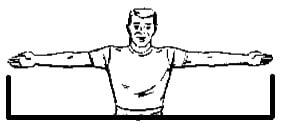One way that Mathematics can be used to benefit our health is to measure dimensions of the body and limbs. Common body dimensions that are measured include:
- arm-span
- height
- hip height
- stride length
Once we understand these measurements, we can look at why these measurements can be important and how these measurements relate to each other and to other major factors like age and gender.
Arm span
Also known as reach, it is the measurement of the length of a person’s arms, fingertips to fingertips.

Arm Span
(Image credit: http://www.gnbco.com/bow_length.php)
Hip Height
Is measured as the distance between your hip line and the bottom of your feet. The hip line is located at the widest part of a person’s hips.

Height
A person’s height is measured from the top of their head to the bottom of their feet, when standing.

Stride Length
The measurement of a person's natural pace, it is the distance between the heel of a person’s footprint and the heel of the same footprint two steps on.

Information about these measurements is published by various sources, such as the Australian Bureau of Statistics (ABS) and medical publications.
Materials
- A tape measure or similar instrument
- A digital tool that can be used to create scatterplots, such as Excel
Instructions
- Measure the height of each student in your class
- Measure the arm span of each student in your class
- Plot the measurements against each other in a scatterplot
Group discussion
- How would you describe the correlation of these two variables?
- If there is a correlation, which variable do you think is the explanatory variable and which is the response variable?
Extension
- The Victorian Department of Education and Early Childhood Development has plotted data on the heights and weights of children from 2 to 18 years old, for both boys and girls. Using the data in these links, create plots of height against weight for both boys and girls aged 13 to 18.
- How would you describe the correlation of these two variables?
- If there is a correlation, which variable do you think is the explanatory variable and which is the response variable?